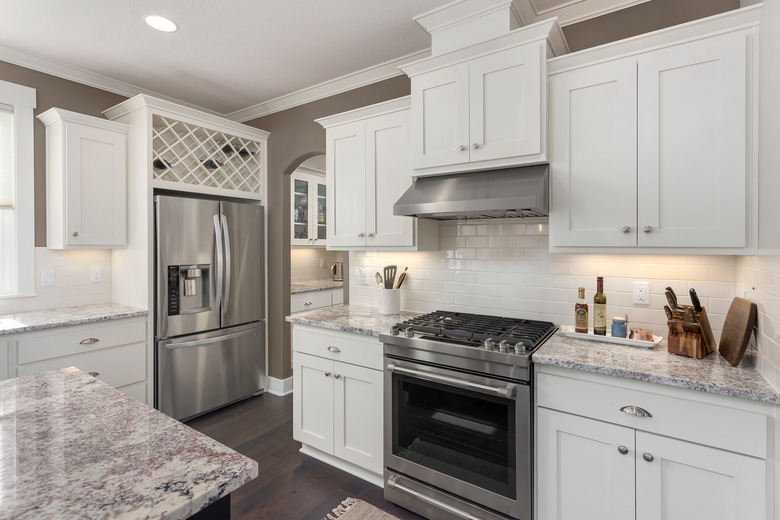How To Tile Over Wallpaper
Wallpaper can add drama and flair like few other decorating techniques but becomes deeply unpopular when it's time for a new look, and one is faced with the wallpaper-removal ordeal. It's tempting to look for easy ways out, like putting tile over wallpaper, but easy isn't necessarily wise — especially in the case of potentially heavy, expensive products like tile.
Tip
Ideally, you won't tile over wallpaper as it can compromise all your hard work. Tiling over remaining wallpaper after attempting removal can be done with some prep.
Should You Tile Over Wallpaper?
Should You Tile Over Wallpaper?
The overwhelming consensus from home decorating centers and tiling companies is, no, you should not tile over wallpaper. There are a few reasons why tiling over wallpaper is problematic, mostly because you're risking your expensive tiling job on a surface where you're cutting corners to prepare. If you want the tiles to stay up for the long haul, it's best to put in the hard work to remove the wallpaper, according to Popular Mechanics.
Not removing the wallpaper means the paper could crumble and deteriorate, damaging the tile adhesion or causing cracks in the future. This is most true of homes where more than one layer of wallpaper exists. When it means tiling over plaster, and stripping the wallpaper could damage the plaster, it'll be a judgment call. See the next section on preparing a wall.
One solution can be peel-and-stick tiles, which can be applied over wallpaper without much prep work — just follow the product's directions. A caveat is that these can come unstuck over time due to steam in bathrooms or kitchens. Plus, they can look "budget" and, if you're trying to sell or rent your space, it may leave prospective buyers or renters wondering if you've cut corners elsewhere.
Preparing a Wall for Tiling
Preparing a Wall for Tiling
Don't dismay, though, because "overwhelming consensus" doesn't mean all pros think tiling over wallpaper is a no-go, so if you're committed to giving it a try, go for it! The trick is to remove as much of the wallpaper as you can. The stuff you can't get off might have real lasting power and be fine for the long term. Some old wallpaper seems like it'll never come off, so use your judgment for how permanent you think it may be.
To remove wallpaper, scuff the surface so water permeates the protective finish. Apply warm water and let it soak in; steamers are popular, but some experts suggest they can force steam deeper into the drywall than wiping water over it does, which can cause drywall and adhesion issues. Use a scraper to remove the wallpaper as best as you can.
Once you've removed most of the wallpaper, wash the walls with TSP and allow them to dry completely. Next, fill or spackle any holes or cracks for a smooth surface and allow it to dry, then sand, vacuum and wipe clean, then allow it to dry again. Once dry, prime the wall so the mortar will stick.
Tiling the Wall
Tiling the Wall
Once you've prepared the wall, proceed with tiling as recommended for the products you're using. Your process begins with planning your pattern and setting up a visual guide to follow so you lay them out straight and consistently.
Next, you'll need thinset mortar mixed to a creamy peanut butter type consistency, which you'll apply in a thin layer with a notched trowel. Then it's time to lay on the tiles, using spacers to achieve a proper grout channel while regularly ensuring that you're keeping the tiles straight.
After drying for 24 hours, you'll be able to apply the grout in small sections. Be sure you don't use sanded grout with glass, metal or polished marble tiles. After the grout dries for 10 minutes, wipe it with a warm, damp sponge. Once the grout dries completely, you'll need to clean the tiles with a grout haze remover, and a few days after that, you'll need to seal the grout and apply silicone sealant in corners.
